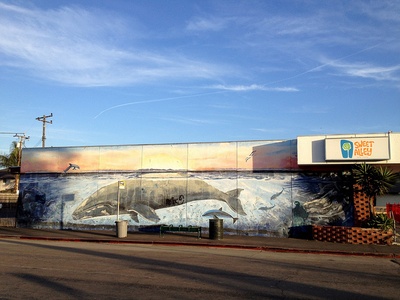Chumash whaling
 See Lost Murals of Isla Vista. November 2011, by Britta Gustafson (CC BY-SA).
See Lost Murals of Isla Vista. November 2011, by Britta Gustafson (CC BY-SA).
The Chumash have a history of interacting with whales, both in the symbiotic way, and in the more detrimental sense. Historically, they’ve been used a food and tool source. The Chumash would not normally hunt whales, but instead wait for them to be washed ashore. Usually this meant a celebration and a feast. Pieces of whale bones were used for splitting wood, which would later be carved. Whalebones were also used as wedges and scrapers. Occasionally, when they were hunted, the Chumash used large canoes called tomols that measured up to 30 feet. Whale bones were also used for house support. On the mainland, archaeological evidence of whale bones have large diameter perforation and worn grooves at either end, and have been identified as shaft- straighteners or throwing sticks (Fagan 1995).
Moreover symbolically, the Chumash believed that whales were driven ashore by swordfish. Because of this, and the importance of whales as a food source, swordfish are culturally revered. One myth within Chumash tradition is that swordfish throw whales around like a ball. When swordfish throw them onto land, they wash ashore. Because of the association between plentiful meat, whales, and swordfish, swordfish have become so revered as to have a ceremonial swordfish dancer, whose ritual was supposed to bring a whale meat bounty. They also consider swordfish to people the ocean counterparts of humans (Blackthorn 1975).
Whaling in the 1800s
In non-Native American populations, whaling has been an impactful presence in the Goleta/Santa Barbara area. Looking towards the bluffs of UCSB from Goleta beach, you can find the whaling station that was active from about 1870-1890 and was the primary headquarters of whale-hunting in the area for the sake of oil for lamps and heating. The outer layer was the only part of the whale desired for oil, so fisherman—drawn to the whaling lifestyle by the allure of living on the beach with their family and having an income every migration season—would leave the carcasses on the beach to rot while they burned the fat to get oil. Hunting whales, however, was extremely dangerous: the whales would aggressively fight back and cause many fishermen to lose their lives, not to mention the danger of the bomb harpoons used to hunt them--which wracked up their own casualties. Fishermen who were a part of the Goleta Company would live in shacks off the west end of Goleta beach, but once the whales became harder to hunt because of skittishness and overall overhunting, these shanties and the whaling industry itself was abandoned.
References
- https://goletahistory.com/goletas-whaling-station/
- Hogg, John, Edwin. Modern Whaling On the California Coast. Los Angeles Times (1886-1922); Jan 30, 1921; ProQuest Historical Newspapers: Los Angeles Times
- Stingle, Kelli Faye. Using Blue Whale (Balaenoptera Musculus) Photographic-identification Sightings to Assess Potential Vessel-whale Encounters in the Santa Barbara Channel. Burnaby, B.C.: Simon Fraser U, 2012. Print.
- Heizer, Robert F., and Albert B. Elsasser. The Natural World of the California Indians. Berkeley, CA: California Indian Library Collections, 1989. Print.
- D Davenport, JR Johnson. “The Chumash and the Swordfish” 1993.
-
Brian Fagan. Time Detectives. New York: Simon & Schuster, 1995. 75-92


